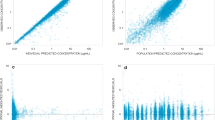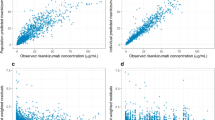Purpose
Efalizumab is a humanized anti-CD11a monoclonal antibody that demonstrated efficacy in the treatment of patients with psoriasis. The objective of this study was to perform a pharmacokinetic (PK)–pharmacodynamic (PD)–efficacy (E) modeling analysis with intersubject variability assessment to increase our understanding of the interaction of efalizumab with CD11a on T cells and consequent reduction in severity of disease in psoriasis patients.
Methods
A total of 6,329 samples from 240 patients in five Phase I and II clinical studies were used in the analysis. For the analysis, plasma efalizumab concentration was used as the PK measurement, the percent of predose CD11a was used as the PD measurement, and the psoriasis area and severity index was used as the measure of efficacy. A receptor-mediated PK/PD model was developed that describes the dynamic interaction of efalizumab binding with CD11a. In the efficacy model, the rate of psoriasis skin production is directly proportional to the amount of free surface CD11a on T cells, which is offset by the rate of skin healing. An additional CD11a-independent component to psoriasis skin production accounted for incomplete response to efalizumab therapy. A Monte Carlo parametric expectation maximization method implemented in the ADAPT II program was used to obtain the estimate of population parameters and inter- and intrasubject variability.
Results and Conclusions
The final model described the PK/PD/E data in psoriasis patients reasonably well. In addition, simulations using the final model suggested that efalizumab administered less frequently could possibly be more convenient with similar efficacy.






Similar content being viewed by others
References
E. Christophers (2001) ArticleTitlePsoriasis–epidemiology and clinical spectrum Clin. Exp. Dermatol. 26 314–320
S. R. Rapp S. R. Feldman M. L. Exum A. B. Fleischer SuffixJr D. M. Reboussin (1999) ArticleTitlePsoriasis causes as much disability as other major medical diseases J. Am. Acad. Dermatol. 41 401–407
J. G. Krueger (2002) ArticleTitleThe immunologic basis for the treatment of psoriasis with new biologic agents J. Am. Acad. Dermatol. 46 1–23
M. Lebwohl S. K. Tyring T. K. Hamilton D. Toth S. Glazer N. H. Tawfik P. Walicke W. Dummer X. Wang M. R. Garovoy D. Pariser (2003) ArticleTitleA novel targeted T-cell modulator, efalizumab, for plaque psoriasis N. Engl. J. Med. 349 2004–2013
K. B. Gordon K. A. Papp T. K. Hamilton P. A. Walicke W. Dummer N. Li B. W. Bresnahan A. Menter (2003) ArticleTitleEfalizumab for patients with moderate to severe plaque psoriasis: a randomized controlled trial JAMA 290 3073–3080
A. Gottlieb J. G. Krueger R. Bright M. Ling M. Lebwohl S. Kang S. Feldman M. Spellman K. Wittkowski H. D. Ochs P. Jardieu R. Bauer M. White R. Dedrick M. Garovoy (2000) ArticleTitleEffects of administration of a single dose of a humanized monoclonal antibody to CD11a on the immunobiology and clinical activity of psoriasis J. Am. Acad. Dermatol. 42 428–435
R. J. Bauer R. L. Dedrick M. L. White M. J. Murray M.R. Garovoy (1999) ArticleTitlePopulation pharmacokinetics and pharmacodynamics of the anti-CD11a antibody hu1124 in human subjects with psoriasis J. Pharmacokinet. Biopharm. 27 397–420
A. B. Gottlieb J. G. Krueger K. Wittkowski R. Dedrick P. A. Walicke M. Garovoy (2002) ArticleTitlePsoriasis as a model for T-cell-mediated disease: immunobiologic and clinical effects of treatment with multiple doses of efalizumab, an anti-CD11a antibody Arch. Dermatol. 138 591–600
D. L. Mortensen, P. A. Walicke, X. Wang, P. Kwon, P. Kuebler, A. B. Gottlieb, J. G. Krueger, C. Leonardi, B. Miller, and A. Joshi. Pharmacokinetics and pharmacodynamics of multiple weekly subcutaneous efalizumab doses in patients with plaque psoriasis. J. Clin. Pharmcol. 45:286–298 (2005).
D. M. Ashcroft A. L. Po ParticleWan H. C. Williams C. E. Griffiths (1999) ArticleTitleClinical measures of disease severity and outcome in psoriasis: a critical appraisal of their quality Br. J. Dermatol. 141 185–191
M. A. Menter G. C. Krueger S. R. Feldman G. D. Weinstein (2003) ArticleTitlePsoriasis treatment 2003 at the new millennium: position paper on behalf of the authors J. Am. Acad. Dermatol. 49 S39–43
S. L. Beal (2001) ArticleTitleWays to fit a PK model with some data below the quantification limit J. Pharmacokinet. Pharmacodyn. 28 481–504
R. J. Bauer S. Guzy (2004) Monte Carlo parametric expectation maximization (MCPEM) method for analyzing population pharmacokinetic/pharmacodynamic (PK/PD) data D. Z. D’Argenio (Eds) Advanced Methods of Pharmacokinetic and Pharmacodynamic System Analysis,Vol. 3 Kluwer Academic Publishers Boston 135–163
D. Z. D’Argenio A Schumitzky (1997) ADAPT II User’s Guide: Pharmacokinetic/Pharmacodynamic System Analysis Software Biomedical Simulation Resource Los Angeles
A. Schumitzky (1995) EM algorithms and two stage methods in pharmacokinetic population analysis D. Z. D’Argenio (Eds) Advanced Methods of Pharmacokinetic and Pharmacodynamic System Analysis,Vol. 3 Plenum Press New York 145–160
W. Krzyzanski W. J. Jusko (1998) ArticleTitleMathematical formalism and characteristics of four basic models of indirect pharmacodynamic responses for drug infusions J. Pharmacokinet. Biopharm. 26 385–408
Y. Yano S. L. Beal L. B. Sheiner (2001) ArticleTitleEvaluating pharmacokinetic/pharmacodynamic models using the posterior predictive check J. Pharmacokinet. Pharmacodyn. 28 171–192
A. Gelman X. L. Meng (1996) Model checking and model improvement W. R. Gilks S. Richardson D. J. Spiegelhalter (Eds) Markov Chain Monte Carlo in Practice Chapman & Hall/CRC Boca Raton 189–202
A. Gelman J. B. Carlin H. S. Stern D. B. Rubin (2004) Bayesian Data Analysis Chapman & Hall/CRC Boca Raton
D. E. Mager W. J. Jusko (2001) ArticleTitleGeneral pharmacokinetic model for drugs exhibiting target-mediated drug disposition J. Pharmacokinet. Pharmacodyn. 28 507–532
A. Sharma W. F. Ebling W. J. Jusko (1998) ArticleTitlePrecursor-dependent indirect pharmacodynamic response model for tolerance and rebound phenomena J. Pharm. Sci. 87 1577–1584
A. B. Gottlieb B. Lifshitz S. M. Fu L. Staiano-Coico C. Y. Wang D. M. Carter (1986) ArticleTitleExpression of HLA-DR molecules by keratinocytes, and presence of Langerhans cells in the dermal infiltrate of active psoriatic plaques J. Exp. Med. 164 1013–1028
S. L. Gottlieb P. Gilleaudeau R. Johnson L. Estes T. G. Woodworth A. B. Gottlieb J. G. Krueger (1995) ArticleTitleResponse of psoriasis to a lymphocyte-selective toxin (DAB389IL-2) suggests a primary immune, but not keratinocyte, pathogenic basis Nat. Med. 1 442–447
H. Lee H. C. Kimko M. Rogge D. Wang I. Nestorov C.C. Peck (2003) ArticleTitlePopulation pharmacokinetic and pharmacodynamic modeling of etanercept using logistic regression analysis Clin. Pharmacol. Ther. 73 348–365
D. R. Mould C. B. Davis E. A. Minthorn D. C. Kwok M. J. Elliott M. E. Luggen M. C. Totoritis (1999) ArticleTitleA populationpharmacokinetic–pharmacodynamic analysis of single doses of clenoliximab in patients with rheumatoid arthritis Clin. Pharmacol. Ther. 66 246–257
A. J. Boeckmann, L. B. Sheiner, and S. L. Beal. NONMEM User’s Guide, University of California San Francisco, San Francisco, 1994.
Acknowledgments
We thank Serge Guzy for contributions to implementation of the MCPEM method, and William Jusko for contributions to the rebound of CD11a portion of the model.
Author information
Authors and Affiliations
Corresponding author
Rights and permissions
About this article
Cite this article
Ng, C.M., Joshi, A., Dedrick, R.L. et al. Pharmacokinetic–Pharmacodynamic–Efficacy Analysis of Efalizumab in Patients with Moderate to Severe Psoriasis. Pharm Res 22, 1088–1100 (2005). https://doi.org/10.1007/s11095-005-5642-4
Received:
Accepted:
Published:
Issue Date:
DOI: https://doi.org/10.1007/s11095-005-5642-4




